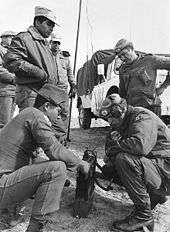Second United Nations Emergency Force
The second United Nations Emergency Forces (UNEF II) was established by United Nations General Assembly, in accordance with United Nations Security Council Resolution 340 (1973), to supervise the ceasefire between Egyptian and Israeli forces at the end of Yom Kippur War (also known as the October War), and following of the agreement of 18 January 1974 and 4 September 1975, to supervise the redeployment of Egyptian and Israeli forces and to man and control the buffer zones established under those agreements.[1]

The mandate of UNEF II was to supervise the implementation of United Nations Security Council Resolution 340 which demanded that an immediate and complete ceasefire between Egyptian and Israeli forces be observed and that the parties return to the positions they had occupied at 1650 hours GMT on 22 October 1973. The Force would use its best efforts to prevent a recurrence of the fighting, and in the fulfillment of its tasks it would have the cooperation of the military observers of the United Nations Truce Supervision Organization (UNTSO). UNEF II was also to cooperate with the International Committee of the Red Cross (ICRC) in its humanitarian endeavours in the area. The mandate of UNEF II which was originally approved for six months, until 24 April 1974, was subsequently renewed eight times. Each time, as the date of expiry of the mandate approached, the Secretary-General submitted a report to the United Nations Security Council on the activities of the Force during the period of the mandate. In each of those reports, the Secretary-General expressed the view that the continued presence of UNEF II in the area was essential, and he recommended, after consultations with the parties, that its mandate be extended for a further period. In each case, the Council took note of the Secretary-General's report and decided to extend the mandate of the Force accordingly. In October 1978, the mandate of UNEF II was extended a last time for nine months, until 24 July 1979.[2] The area of operation of the UNEF II was at Suez Canal sector and later the Sinai Peninsula, with the headquarters located at Cairo (October 1973 to August 1974) and Ismaïlia (August 1974 – July 1979).[1] The deployment of forces as of July 1979 was as follows:
- Buffer zone 1 (boundary: Mediterranean Sea, line J, line M and line E)
- Swedbatt (Swedish battalion)
- Ghanbatt (Ghanaian battalion)
- Indbatt (Indonesian battalion)
- Bufferzone 2A (boundary: Bufferzone 1, line M, bufferzone 2B, and Gulf of Suez)
- Indbatt (Indonesian battalion)
- Finbatt (Finnish battalion)
- Bufferzone 2B (boundary: bufferzone 2A, line M, Gulf of Suez)
- Finbatt (Finnish battalion)[3]
Force commanders
- Lieutenant-General Ensio P. H. Siilasvuo (Finland) (October 1973 – August 1975)
- Lieutenant-General Bengt Liljestrand (Sweden) (August 1975 – November 1976)
- Major-General Rais Abin (Indonesia) (December 1976 – September 1979).
References
- "Middle East – UNEF II". www.un.org. Department of Public Information, United Nations. Retrieved 14 December 2014.
- UNEF II mandate Archived September 12, 2009, at the Wayback Machine
- The Blue Helmets: a review of United Nations peace-keeping (2 ed.). New York: United Nations Department of Public Information. 1990. p. 423. ISBN 92-1-100444-6. Retrieved 14 December 2014.
